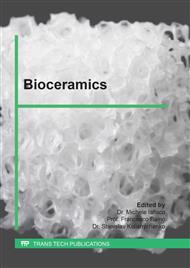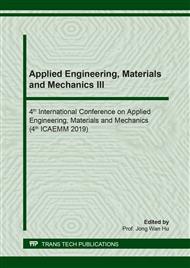[1]
C. Nascimento, J.P.M. Issa, R.R. Oliveira, M. M. Iyomasa, S. Siessere, S.C.H. Regalo, Biomaterials Applied to the Bone Healing Proccess, Int. J. Morphol. 25(4) (2007) 839-846.
DOI: 10.4067/s0717-95022007000400025
Google Scholar
[2]
A.J. Rahyussalim, S. Ifran, et al. The Needs of Current Implant Technology in Orthopaedic Prosthesis Biomaterials Application to Reduce Prosthesis Failure Rate, J. Nanomater.2016(3) (2016) 1-9.
DOI: 10.1155/2016/5386924
Google Scholar
[3]
S. Rujitanapanich, P. Kumpapan. P. Wanjanoi, Synthesis of Hydroxyapatite from Oyster Shell via Precipitation, Energy Procedia,56 (2014) 112-117.
DOI: 10.1016/j.egypro.2014.07.138
Google Scholar
[4]
E. Landi, A. Tampieri, G. Celotti, L. Vichi, M. Sandri, Influence of Synthesis and Sintering Parameters on the Characteristics of Carbonate Apatite, Biomater. 25(10) (2004) 1763-1770.
DOI: 10.1016/j.biomaterials.2003.08.026
Google Scholar
[5]
R. Z. LeGeros, Calcium Phosphates in Oral Biology and Medicine, Monogr. Oral Sci.15 (1991) Basel: S Karger Pub.
Google Scholar
[6]
R. Othman, Z. Mustafa, C. W. Loon,A. F. M. Noor, Effect of Calcium Precusors and pH on The Precipitation of Carbonated Hydroxyapatite, Procedia Chem. 19 (2016) 539-545.
DOI: 10.1016/j.proche.2016.03.050
Google Scholar
[7]
M.G. Raucci, V.Guarino, L. Ambrosio, Hybrid Composite Scaffolds Prepared by Sol–Gel Method for Bone Regeneration, Compos. Sci.Technol. 70(13) (2010) 1861-1868.
DOI: 10.1016/j.compscitech.2010.05.030
Google Scholar
[8]
J. Barralet, S. Best, W. Bonfield, Carbonate Substitution in Precipitated Hydroxyapatite: An Investigation into the Effects of Reaction Temperature and Bicarbonate Ion Concentration, J. Biomed. Mater. Res.41(1) (1998) 79-86.
DOI: 10.1002/(sici)1097-4636(199807)41:1<79::aid-jbm10>3.0.co;2-c
Google Scholar
[9]
N. Jia, L. Shu-Ming, M. Ming-Guo, S. Run-Cang, Z. Jie-Fang, Hydrothermal Synthesis and Characterization of Cellulose-Carbonated Hydroxyapatite Nanocomposites in NaOH-Urea Aqueous Solution, Sci.Adv. Mater. 2(2) (2010) 210-214(5).
DOI: 10.1166/sam.2010.1086
Google Scholar
[10]
C. Balazsi, F. Weber, Z. Kover, E. Horvath, C. Nemeth, Preparation of Calcium-Phospate Bioceramics from Natural Resources, J. Eur. Ceram. Soc. 27(2-3) (2007) 1601-1606.
Google Scholar
[11]
Y. Rizkayanti, Y. Yusuf, Optimization of the Temperature Synthesis of Hydroxyapatite from Indonesian Crab Shells, Int. J.Nanoelectro.Mater. 12(1) (2019) 85-92.
Google Scholar
[12]
T. Lonapakul, Synthesis of Hydroxyapatite from Biogenic Waste, KKU Eng. J.42(3) (2015) 269-275.
Google Scholar
[13]
A. Pal, S. Maity, S. Chabri, S. Bera, A. R. Chowdhury, M. Das, A. Sinha, Mechanochemical Synthesis of Nanocrystalline Hydroxyapatite fromMercenaria Clam Shells and Phosphoric Acid, Biomed. Phys. Eng. Express. 3(1) (2017).
DOI: 10.1088/2057-1976/aa54f5
Google Scholar
[14]
M. N. Salimi, R. H. Bridson, L. M. Grover,G. A.Leeke, Effect of Processing Conditions on the Formation of Hydroxyapatite Nanoparticles, Powder Technol. 218 (2012) 109-118.
DOI: 10.1016/j.powtec.2011.11.049
Google Scholar
[15]
S. Mondal, B. Mondal, A. Dey, S.S. Mukhopadhyay, Studies on processing and Characterization of Hydroxyapatite Biomaterials from Different Bio Wastes, J. Minerals Mater. Charac. Eng. 11(1) (2012) 55-67.
DOI: 10.4236/jmmce.2012.111005
Google Scholar
[16]
M. Sari, Y. Yusuf, Synthesis and Characterization of Hydroxyapatite based on Green Mussel Shells (Perna viridis) with Calcination Temperature Variation Using the Precipitation Method, Int. J.Nanoelectro. Mater. 11(3) (2018) 357-370.
DOI: 10.1088/1757-899x/432/1/012046
Google Scholar
[17]
S. Ramesh, K.L. Aw, R. Tolouei, M. Amiriyan, C. Y. Tan, M. Hamdi, Sintering Properties of Hydroxyapatite Powders Prepared using Different Methods, Ceram. Int. 39(1)(2013) 111-119.
DOI: 10.1016/j.ceramint.2012.05.103
Google Scholar
[18]
A. Solodyankina, A. Nikolaev, O. F. Kamenetskaya, O. Golovanova, Synthesis and Characterization of Nanocrystalline Apatites from Solution Modeling Human Blood, J.Molecular Struct. 1119 (2016) 484-489.
DOI: 10.1016/j.molstruc.2016.04.080
Google Scholar



